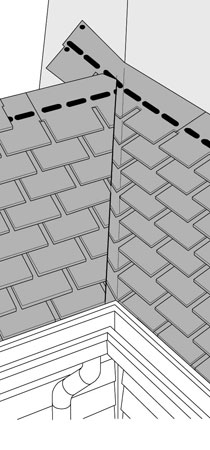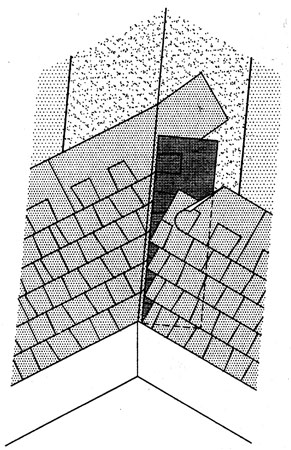The term "California valley" likely conjures up thoughts of Silicon Valley, Napa Valley and other high-profile geographic locations. However, for steep-slope roof systems incorporating asphalt shingles, "California valley" or "closed-cut California valley" refers to a distinctive style of asphalt shingle valley construction.
A conventional closed-cut valley and closed-cut California valley are illustrated in Figures 1 and 2, respectively. Underlayment and valley flashing are installed the same way in both roof systems. The initial shingle courses also are installed the same way by applying the shingles on the roof plane that has a lower slope or, if slopes are equal, the plane with lesser height. The shingle courses are applied so a full strip is run through the valley at the end of each course 12 to 18 inches onto the adjoining roof plane. Each system also employs a 2-inch offset from the valley center line for aligning the cut or straight edge of the intersecting roof plane.

Figure 1: A conventional closed-cut valley as shown in The NRCA Roofing and Waterproofing Manual—Fifth Edition
The conventional closed-cut valley shown in Figure 1 runs the shingle courses on the adjoining plane through the valley center line onto the first plane, and the shingles are cut in a straight line along the 2-inch offset. The upper corner of each shingle strip in the valley cut is trimmed to restrict water from migrating under the shingle. In regions susceptible to heavy rainfall and snow, the cut ends of shingle strips also are set in a bead of roof cement.
The closed-cut California valley shown in Figure 2 has a row of shingle strips applied vertically with the exposure edge facing the valley set along the 2-inch offset line. The shingles on the adjoining plane are positioned by setting the tip of each course's shingle on the leading edge of the vertical shingle and covering the vertical shingle.

Figure 2: An example of a closed-cut California valley
Advantages of a closed-cut California valley include the elimination of all cutting and the straight-edge template in the valley's center zone. However, I question the aesthetics of possibly creating a hump along the valley line, particularly as the thickness of the selected shingle increases. I also question reconciling a prescribed manufacturer's offset dimension for a specific shingle.
Minimum design effects are prescribed to minimize lateral water migration in a shingle matrix, as well as achieve a designed aesthetic offset of a roof system. The offset distance created by aligning the corner of each successive shingle course with a valley line decreases as a roof plane's slope increases.
NRCA does not recommend a closed-cut California valley construction in climates that experience snow loads or heavy rainfall (in terms of frequency or intensity) or in locations that are exposed to accumulation of debris, such as leaves and other natural elements.
Tom Bollnow is NRCA's senior director of technical services.

